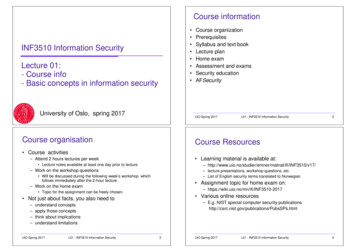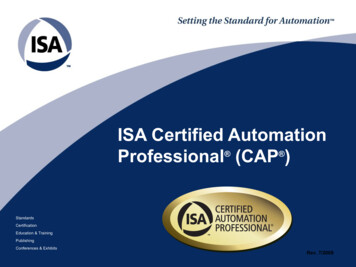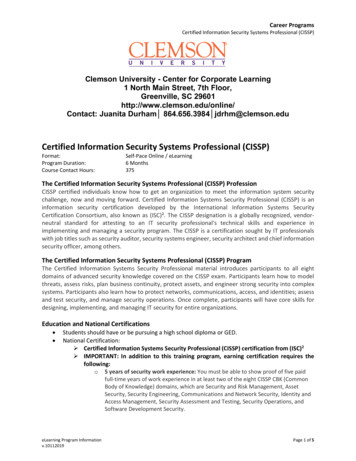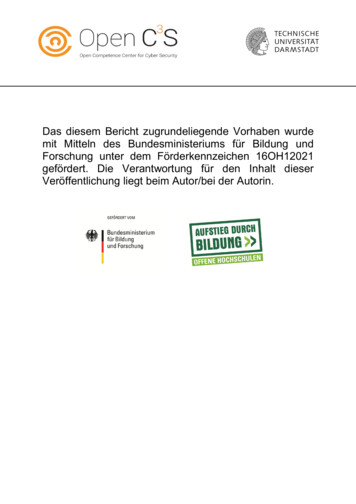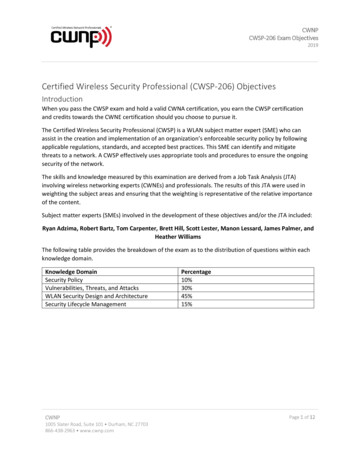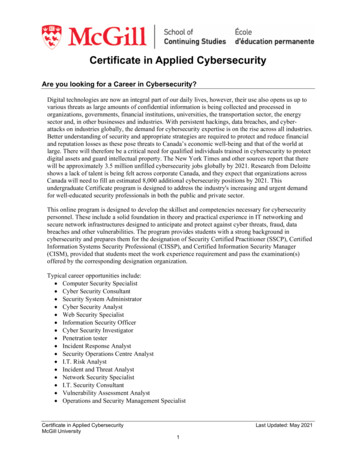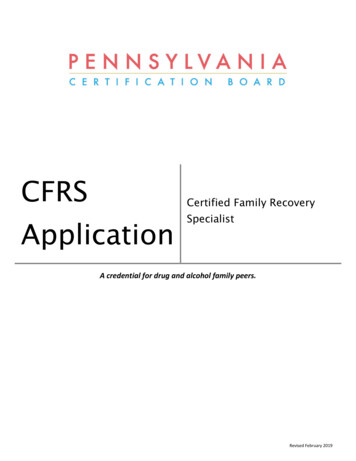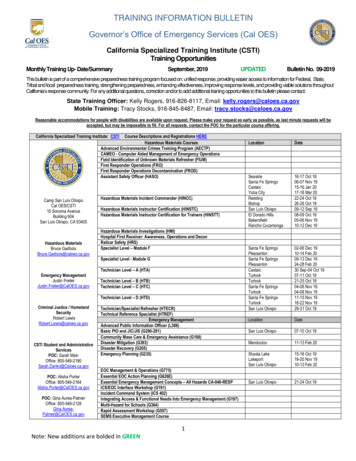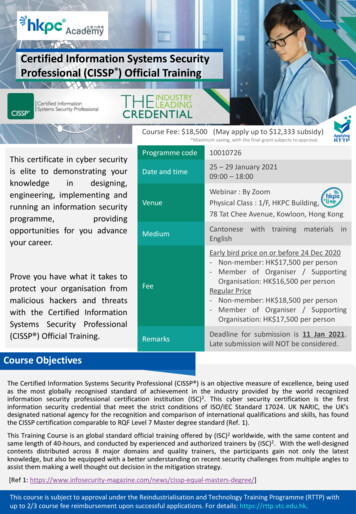
Transcription
Certified Information Systems SecurityProfessional (CISSP ) Official TrainingCourse Fee: 18,500 (May apply up to 12,333 subsidy)*Maximum saving, with the final grant subjects to approval.This certificate in cyber securityis elite to demonstrating yourknowledgeindesigning,engineering, implementing andrunning an information securityprogramme,providingopportunities for you advanceyour career.Prove you have what it takes toprotect your organisation frommalicious hackers and threatswith the Certified InformationSystems Security Professional(CISSP ) Official Training.Programme code10010726Date and time25 – 29 January 202109:00 – 18:00VenueWebinar : By ZoomPhysical Class : 1/F, HKPC Building,78 Tat Chee Avenue, Kowloon, Hong KongMediumCantonese with training materials inEnglishFeeEarly bird price on or before 24 Dec 2020- Non-member: HK 17,500 per person- Member of Organiser / SupportingOrganisation: HK 16,500 per personRegular Price- Non-member: HK 18,500 per person- Member of Organiser / SupportingOrganisation: HK 17,500 per personRemarksDeadline for submission is 11 Jan 2021.Late submission will NOT be considered.Course ObjectivesThe Certified Information Systems Security Professional (CISSP ) is an objective measure of excellence, being usedas the most globally recognised standard of achievement in the industry provided by the world recognizedinformation security professional certification institution (ISC)2. This cyber security certification is the firstinformation security credential that meet the strict conditions of ISO/IEC Standard 17024. UK NARIC, the UK’sdesignated national agency for the recognition and comparison of international qualifications and skills, has foundthe CISSP certification comparable to RQF Level 7 Master degree standard (Ref. 1).This Training Course is an global standard official training offered by (ISC)2 worldwide, with the same content andsame length of 40-hours, and conducted by experienced and authorized trainers by (ISC)2. With the well-designedcontents distributed across 8 major domains and quality trainers, the participants gain not only the latestknowledge, but also be equipped with a better understanding on recent security challenges from multiple angles toassist them making a well thought out decision in the mitigation strategy.[Ref 1: qual-masters-degree/]This course is subject to approval under the Reindustrialisation and Technology Training Programme (RTTP) withup to 2/3 course fee reimbursement upon successful applications. For details: https://rttp.vtc.edu.hk.
Certified Information Systems SecurityProfessional (CISSP ) Official TrainingCourse Topics at a GlanceThe Certified Information Systems Security Professional (CISSP) is the mostglobally recognised certification in the information security market. Itvalidates an information security professional’s deep technical andmanagerial knowledge and experience to effectively design, engineer, andmanage the overall security posture of an organisation.The broad spectrum of topics included in the CISSP Common Body ofKnowledge (CBK ) ensure its relevancy across all disciplines in the field ofinformation security.DateActivitiesDay 125 Jan 2021 (Mon) Security and Risk ManagementAsset SecurityDay 226 Jan 2021 (Tue) Asset SecuritySecurity Architecture and EngineeringDay 327 Jan 2021 (Wed) Security Architecture and EngineeringCommunication and Network SecurityIdentity and Access Management (IAM)Day 428 Jan 2021 (Thu) Identity and Access Management (IAM)Security Assessment and TestingSecurity OperationsDay 529 Jan 2021 (Fri) Security OperationsSoftware Development SecurityCourse BenefitsThis course will help participants review and refresh their cloud securityknowledge and identify areas they need to study for the CISSP exam andfeatures: Official (ISC)2 courseware Taught by an authorised (ISC)2 instructor Student handbook Collaboration with classmates Real-world learning activities and scenarios A certificate of completionInquiry Ms Judy LIU 852 2788 5704 judysmliu@hkpc.org
Certified Information Systems SecurityProfessional (CISSP ) Official TrainingTraining Outline1. Security and Risk Management1.1 Understand and apply concepts of confidentiality, integrity and availability1.2 Evaluate and apply security governance principles Alignment of security function to business strategy, goals, mission, andobjectives Organisational processes (e.g., acquisitions, divestitures, governancecommittees) Organizational roles and responsibilities Security control frameworks Due care/due diligence1.3 Determine compliance requirements Contractual, legal, industry standards, and regulatory requirements Privacy requirements1.4 Understand legal and regulatory issues that pertain to information security in aglobal context Cyber crimes and data breaches Licensing and intellectual property requirements Import/export controls Trans-border data flow Privacy1.5 Understand, adhere to, and promote professional ethics (ISC)² Code of Professional Ethics Organisational code of ethics1.6 Develop, document, and implement security policy, standards, procedures, andguidelines1.7 Identify, analyse, and prioritize Business Continuity (BC) requirements Develop and document scope and plan Business Impact Analysis (BIA)1.8 Contribute to and enforce personnel security policies and procedures Candidate screening and hiring Employment agreements and policies Onboarding and termination processes Vendor, consultant, and contractor agreements and controls Compliance policy requirements Privacy policy requirements1.9 Understand and apply risk management concepts Identify threats and vulnerabilities Risk assessment/analysis Risk response Countermeasure selection and implementationInquiry Ms Judy LIU 852 2788 5704 judysmliu@hkpc.org
Certified Information Systems SecurityProfessional (CISSP ) Official TrainingTraining Outline1. Security and Risk Management Applicable types of controls (e.g. preventive, detective, corrective) Security Control Assessment (SCA) Monitoring and measurement Asset valuation Reporting Continuous improvement Risk frameworks1.10 Understand and apply threat modeling concepts and methodologies Threat modeling methodologies Threat modeling concepts1.11 Apply risk-based management concepts to the supply chain Risks associated with hardware, software, and services Third-party assessment and monitoring Minimum security requirements Service-level requirements1.12 Establish and maintain a security awareness, education, and training programme Methods and techniques to present awareness and training Periodic content reviews Program effectiveness evaluation2. Asset Security2.1 Identify and classify information and assets Data classification Asset classification2.2 Determine and maintain information and asset ownership2.3 Protect privacy Data owners Data processers Data remanence Collection limitation2.4 Ensure appropriate asset retention2.5 Determine data security controls Understand data states Scoping and tailoring Standards selection Data protection methods2.6 Establish information and asset handling requirementsInquiry Ms Judy LIU 852 2788 5704 judysmliu@hkpc.org
Certified Information Systems SecurityProfessional (CISSP ) Official TrainingTraining Outline3. Security Architecture and Engineering3.13.23.33.4Implement and manage engineering processes using secure design principlesUnderstand the fundamental concepts of security modelsSelect controls based upon systems security requirementsUnderstand security capabilities of information systems (e.g., memory protection,Trusted Platform Module (TPM), encryption/decryption)3.5 Assess and mitigate the vulnerabilities of security architectures, designs, andsolution elements Client-based systems Server-based systems Database systems Cryptographic systems Industrial Control Systems (ICS) Cloud-based systems Distributed systems Internet of Things (IoT)3.6 Assess and mitigate vulnerabilities in web-based systems3.7 Assess and mitigate vulnerabilities in mobile systems3.8 Assess and mitigate vulnerabilities in embedded devices3.9 Apply cryptography Cryptographic life cycle (e.g., key management, algorithm selection) Cryptographic methods (e.g., symmetric, asymmetric, elliptic curves) Public Key Infrastructure (PKI) Key management practices Digital signatures Non-repudiation Integrity (e.g., hashing) Understand methods of cryptanalytic attacks Digital Rights Management (DRM)3.10 Apply security principles to site and facility design3.11 Implement site and facility security controls Wiring closets/intermediate distribution facilities Server rooms/data centers Media storage facilities Evidence storage Restricted and work area security Utilities and Heating, Ventilation, and Air Conditioning (HVAC) Environmental issues Fire prevention, detection, and suppressionInquiry Ms Judy LIU 852 2788 5704 judysmliu@hkpc.org
Certified Information Systems SecurityProfessional (CISSP ) Official TrainingTraining Outline4. Communication and Network Security4.1 Implement secure design principles in network architectures Open System Interconnection (OSI) and Transmission ControlProtocol/Internet Protocol (TCP/IP) models Internet Protocol (IP) networking Implications of multilayer protocols Converged protocols Software-defined networks Wireless networks4.2 Secure network components Operation of hardware Transmission media Network Access Control (NAC) devices Endpoint security Content-distribution networks4.3 Implement secure communication channels according to design Voice Multimedia collaboration Remote access Data communications Virtualized networks5. Identity and Access Management (IAM)5.1 Control physical and logical access to assets Information Systems Devices Facilities5.2 Manage identification and authentication of people, devices, and services Identity management implementation Single/multi-factor authentication Accountability Session management Registration and proofing of identity Federated Identity Management (FIM) Credential management systems5.3 Integrate identity as a third-party service On-premise Cloud FederatedInquiry Ms Judy LIU 852 2788 5704 judysmliu@hkpc.org
Certified Information Systems SecurityProfessional (CISSP ) Official TrainingTraining Outline5. Identity and Access Management (IAM)5.4 Implement and manage authorization mechanisms Role Based Access Control (RBAC) Rule-based access control Mandatory Access Control (MAC) Discretionary Access Control (DAC) Attribute Based Access Control (ABAC)5.5 Manage the identity and access provisioning lifecycle User access review System account access review Provisioning and deprovisioning6. Security Assessment and Testing6.1 Design and validate assessment, test, and audit strategies Internal; External; Third-party6.2 Conduct security control testing Vulnerability assessment Penetration testing Log reviews Synthetic transactions Code review and testing Misuse case testing Test coverage analysis Interface testing6.3 Collect security process data (e.g., technical and administrative) Account management Management review and approval Key performance and risk indicators Backup verification data Training and awareness Disaster Recovery (DR) and Business Continuity (BC)6.4 Analyze test output and generate report6.5 Conduct or facilitate security audits Internal; External; Third-partyInquiry Ms Judy LIU 852 2788 5704 judysmliu@hkpc.org
Certified Information Systems SecurityProfessional (CISSP ) Official TrainingTraining Outline7. Security Operations7.1 Understand and support investigations Evidence collection and handling Reporting and documentation Investigative techniques Digital forensics tools, tactics, and procedures7.2 Understand requirements for investigation types Administrative Criminal Civil Regulatory7.3 Industry standardsConduct logging and monitoring activities Intrusion detection and prevention Security Information and Event Management (SIEM) Continuous monitoring Egress monitoring7.4 Securely provisioning resources Asset inventory Asset management Configuration management7.5 Understand and apply foundational security operations concepts Need-to-know/least privileges Separation of duties and responsibilities Privileged account management Job rotation Information lifecycle Service Level Agreements (SLA)7.6 Apply resource protection techniques Media management Hardware and software asset management7.7 Conduct incident management Detection Response Mitigation Reporting Recovery Remediation Lessons learnedInquiry Ms Judy LIU 852 2788 5704 judysmliu@hkpc.org
Certified Information Systems SecurityProfessional (CISSP ) Official TrainingTraining Outline7. Security Operations7.8 Operate and maintain detective and preventative measures Firewalls Intrusion detection and prevention systems Whitelisting/blacklisting Third-party provided security services Sandboxing Honeypots/Honeynets Anti-malware7.9 Implement and support patch and vulnerability management7.10 Understand and participate in change management processes7.11 Implement recovery strategies Backup storage strategies Recovery site strategies Multiple processing sites System resilience, high availability, Quality of Service (QoS), and faulttolerance7.12 Implement Disaster Recovery (DR) processes Response Personnel Communications Assessment Restoration Training and awareness7.13 Test Disaster Recovery Plans (DRP) Read-through/tabletop Walkthrough Simulation Parallel Full interruption7.14 Participate in Business Continuity (BC) planning and exercises7.15 Implement and manage physical security Perimeter security controls Internal security controls7.16 Address personnel safety and security concerns Travel Security training and awareness Emergency management DuressInquiry Ms Judy LIU 852 2788 5704 judysmliu@hkpc.org
Certified Information Systems SecurityProfessional (CISSP ) Official TrainingTraining Outline8. Software Development Security8.1 Understand and integrate security in the Software Development Life Cycle (SDLC) Development methodologies Maturity models Operation and maintenance Change management Integrated product team8.2 Identify and apply security controls in development environments Security of the software environments Configuration management as an aspect of secure coding Security of code repositories8.3 Assess the effectiveness of software security Auditing and logging of changes Risk analysis and mitigation8.4 Assess security impact of acquired software8.5 Define and apply secure coding guidelines and standards Security weaknesses and vulnerabilities at the source-code level Security of application programming interfaces Secure coding practicesMode of DeliveryOnline/Classroom-based Training The most thorough review of the CISSP CBK, industry concepts and bestpractices Five-day classes; eight hours per day Available at (ISC)² facilities and through (ISC)² Official Training ProvidersworldwideInquiry Ms Judy LIU 852 2788 5704 judysmliu@hkpc.org
Certified Information Systems SecurityProfessional (CISSP ) Official TrainingTrainersMr Bernard KANBernard KAN is an (ISC)2 Certified Trainer with over 20 years of information securityexperience as a security team leader in Banking, Telecommunication industry andCERT community.Bernard has been delivering information security training to enterprises, talks to thepublic in security conference and sharing sessions to NGOs and he was a frequentspeaker for security awareness training.He was a part-time lecturer for City University of Hong Kong for a post-graduateInformation Security certificate course for 6 years.Bernard acquired several professional certifications including CISSP, GCIA, GCIH,CWSP, CCNP, MCSE and CEC. He also has a Master of Science degree in ECommerce.Mr Peter CHEUNGPeter CHEUNG is an (ISC)2 Certified Trainer with over 20 years of experience in ITindustry. He is currently working in MNC as Regional Security Officer and OperationalSecurity Readiness Manager, with experience in vulnerability management, incidentmanagement, risk management, security assessment and review. Before that, heworked in a global IT vendor as Network Security Specialist and Network Manager ofa Datacenter.Inquiry Ms Judy LIU 852 2788 5704 judysmliu@hkpc.org
Certified Information Systems SecurityProfessional (CISSP ) Official TrainingTarget ParticipantTo qualify for this cybersecurity certification, you must have: At least five years of cumulative, paid, full-time work experience; In two or more of the eight domains of the (ISC)2 CISSP Common Body ofKnowledge (CBK). Don’t have enough work experience yet? There are two ways you can overcomethis obstacle.Satisfy one year of required experience with: A four-year college degree (or a regional equivalent). Or, y.Take and pass the CISSP exam to earn an Associate of (ISC)2 designation. Then,you’ll have up to six years to earn your required work experience for the CISSP.This course is ideal for experienced security practitioners, managers, and executivesinterested in proving their knowledge across a wide array of security practices andprinciples.Suitable for:- Chief Information Security Officer- Chief Information Officer- Director of Security- IT Director/Manager- Security Systems Engineer- Security Analyst- Security Manager- Security Auditor- Security Architect- Security Consultant- Network ArchitectCertificate AwardParticipants who have attained at least 80% attendance of lecture will be awarded acertificate of completion issued by The International Information SystemSecurity Certification Consortium, Inc., (ISC)2.Inquiry Ms Judy LIU 852 2788 5704 judysmliu@hkpc.org
Certified Information Systems SecurityProfessional (CISSP ) Official TrainingCISSP Examination Procedures(ISC)² has introduced Computerised Adaptive Testing (CAT) for all English CISSP examsworldwide. You can visit the computer-based testing partner at www.pearsonvue.com/isc2to set up your account, schedule your exam and settle payment directly. On yourscheduled exam day, you’ll have THREE hours to complete the 100 - 150 exam questions.You must pass the exam with a scaled score of 700 points or greater. For more details,please visit: https://www.isc2.org/Certifications/CISSP.If you would like to understand more about the exam, kindly view the link:https://www.isc2.org/Register-for-Exam for your reference.RTTP Training Grant ApplicationCompanies should submit their RTTP training grant application for their employee(s) via https://rttp.vtc.edu.hk/rttp/login at least two weeks beforecourse commencement. Alternatively, application form could be submitted by email to rttp@vtc.edu.hk along with supporting documents.Enrolment method1.Scan the QR code to complete the enrolment and payment online.2.Mail the crossed cheque with payee name “Hong KongProductivity Council” (in HK dollar) and the application formshould be mailed to Hong Kong Productivity Council, 2/F, HKPCBuilding, 78 Tat Chee Avenue, Kowloon (attention to Ms Judy LIU).Please indicate the course name and course code on theenvelope.(Only receipt printed with receipt printers at HKPC is valid. Receipt ofcheque payment is subject to bank eDetail.jspx/10010726Inquiry Ms Judy LIU 852 2788 5704 judysmliu@hkpc.org
the CISSP certification comparable to RQF Level 7 Master degree standard (Ref. 1). This Training Course is an global standard official training offered by (ISC)2 worldwide, with the same content and same length of 40-hours, and conducted by experienced and authorized trainers by (ISC)2. With the well-designed

